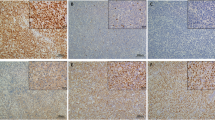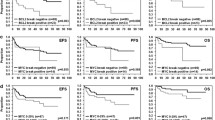Abstract
We analyzed 104 patients with non-Hodgkin’s lymphoma, follicular or diffuse large-B-cell-type lymphoma, in order to evaluate the correlation between clinical characteristics and immunohistochemical parameters. Immunostaining was performed by means of monoclonal antibodies against Ki-67, bcl-2, and p53 expression. Forty-nine of the patients showed follicular lymphoma. A high expression of bcl-2 was found in 93%, high expression of p53 in 57%, and low expression of Ki-67 in 96%. Follicular lymphoma grade III showed a p53 expression (p=0.07) slightly higher than follicular lymphoma grades I and II, not reaching statistical significance. Follicular lymphoma grades I and II tended to express lower Ki-67 and higher levels of bcl-2 expression than grade III (p=0.06). Fifty-five cases showed diffuse large-B-cell lymphoma. Among them, bcl-2 was absent in 39%, whereas p53 and Ki-67 expression were high in 38%. In the diffuse large-B-cell lymphomas, a high bcl-2 expression correlated with stages III and IV (p=0.03) and involvement of more than one extranodal area (p=0.03). High Ki-67 expression was also associated to extranodal involvement of more than one area (p=0.03). Overall survival of patients did not show statistically significant differences regarding Ki-67, bcl-2, and p53 tumoral expression. Prognostic factors for overall survival in the multivariate analysis were age (p=0.02) and LDH (p=0.003). Time to progression was worse among follicular lymphoma with high p53 expression than with mild/moderate p53 expression (p=0.009).
Similar content being viewed by others
References
The International Non-Hodgkin’s Lymphoma Prognostic Factors Project. (1993) A predictive model for aggressive non-Hodkin’s lymphoma. N. Engl. J. Med. 329:987–994.
Swan, F., Velasquez, W.S., Tucker, S., et al. (1989). A new serologic lymphomas based on initial β2-microglobulin and lactate dehydrogenase levels. J. Clin. Oncol. 7:1518–1527.
Hermine, O., et al. (1996). Prognostic significance of bcl-2 protein expression in aggressive non-Hodgkin’s lymphoma. Blood 87:265–272.
Hill, M.E., MacLennan, K.A., Cunningham, D.C., et al. (1996). Prognostic significance of bcl-2 expression and bcl-2 major breakpoint region rearrangement in diffuse large cell non-Hodgkin’s lymphoma: a British National Lymphoma Investigation Study. Blood 88:1046–1051.
Wilson W., Teruya-Feldstein J., Fest T., et al. (1997). Relationship of p53, bcl-2, and tumor proliferation to clinical drug resistance in non-Hodgkin’s lymphomas. Blood 89:601–609.
Kramer, M.H.H, Hermans, J., Parker, J., et al. (1996). Clinical significance of bcl-2 and p53 protein expression in diffuse large B-cell lymphoma; a population based study. J. Clin. Oncol. 14:2131–2138.
Cooper, K., and Haffajee, Z. (1997). Bcl-2 and p53 protein expression in follicular lymphoma. J. Pathol. 182:307–310.
Sander, C.A., Yano, T., Clark, H.M., et al. (1993). p53 mutation is associated with progression in follicular lymphomas. Blood 82:1994–2004.
Adamson, D.J.A. Thompson, W.D., Dawson, A.A., Bennett, B., and Haites, E.N. (1995). p53 mutation and expression in lymphoma. Br. J. Cancer 72:150–154.
Zoldan, M.A., Inghirami, G., Masuda, Y. and Vandekerckhove, R.B. (1996). Large cell variants of mantle cell lymphoma: cytologic characteristics and p53 anomalies may predict poor outcome. Br. J. Haematol. 93:475–486.
Greiner, T.C., Moynihan M.J., Chan W.C., et al. (1996). P53 mutations in mantle cell lymphoma are associated with variant cytology and predict a poor prognosis. Blood 87:4302–4310.
Koduru, P.R.K., Raju, K., Vadmal. V., et al. (1997). Correlation between mutation in p53, p53 expression, cytogenetics, histologic type, and survival in patients with B-cell non-Hodgkin’s lymphoma. Blood 90:4078–4091.
Hall, P.A., Richards, M.A., Gregory, W.M., et al. (1988). The prognostic value of Ki67 immunostaging in non-Hodgkin’s lymphoma. J. Pathol. 154:223–235.
Grogan, T.M., Lipprnan, S.M., Spier, C.M., et al. (1988). Independent prognostic significance of a nuclear proliferation antigen in diffuse large cell lymphomas as determined by the monoclonal antibody Ki67. Blood 71:1157–1160.
Miller, T.P., Grogan, T.M., Dahlberg, S., et al. (1994). Prognostic significance of the Ki67 associated proliferate antigen in aggressive non-Hodgkin’s lymphomas: a prospective Southwest Oncology Group Trial. Blood 83:1460–1466.
Grogan, T. (1998). Immunohisto-chemistry of lymphoma, in The Lymphomas (G. Canellos, T.A. Lister, and J.L. Sklar, eds.), pp. 151–183. W.B. Saunders Philadelphia.
Barnard, N.J., Hall, P.A., Lemoine, N.R. and Kadar, N. (1987). Proliferative index in breast carcinoma determined in situ by ki67 immunostaining and its relationship to clinical and pathological variables. J. Pathol. 152:287–295.
Kaplan, E.L. and Meier, P. (1958). Nonparametric estimation from incomplete observations. J. Am. Stat. Assoc. 53:457–481.
Peto, R. and Peto, J. (1972). Asymptotically efficient rank invariant test procedures. J. Roy. Statist. Soc. A 35:185–206.
Cox, D.R. (1972). Regressions model and life tables. J. Roy. Statist Soc. B 34:187–220.
Hiddemann, W., Longo, D.L., Coiffier, B., et al. (1996). Lymphoma classification: the gap between biology and clinical management is closing. Blood 88:4085–4089.
Gascoyne, R. D. (1997). Pathologic prognostic factors in diffuse aggressive non-Hodgkin’s lymphoma. Hematol./Oncol. Clin. North Am. 11:847–862.
Morente, M.M. (1998). Factores pronósticos en los linfomas no Hodgkinianos, in 5° Curso de Hematopatología, (T. Alvaro, R. Bosch, R. Font, S. Martínez, and M.T. Salvadó, eds.), pp. 131–152, Hosp Tortosa Verge de la Cinta, Tarragona, Spain.
Magrath, I. (1992). Molecular basis of lymphomagenesis. Cancer Res. 52(Suppl. 19):5529s-5540s.
Reed, J.C. (1994). Bcl-2 and the regulation of programmed cell death. J. Cell Biol. 124:1–6.
Gaulard, P., d’Agay M.F., Peuelnnaur, M., et al. (1992). Expression of the bcl-2 gene product in follicular lymphoma. Ann. J. Pathol. 140:1089–1095.
Kondo, E., Yoshino, T., Yamadori, I., et al. (1994). Expression of bcl-2 protein and Fas antigen in Non-Hodgkin’s lymphomas. Ann. J. Pathol. 145:330–337.
Mrózek, K. and Bloomfield, C.D. (1998). Major cytogenetic findings in non-Hodgkin’s lymphoma, in The lymphomas, (G. Canellos, T.A. Lister, and J.L. Sklar, eds.), pp. 107–128, W.B. Saunders, Philadelphia.
Pezzella, F., Jones, M., Ralfkiaer, E., et al. (1992). Evaluation of bcl-2 protein expression and (14:18) translocation prognostic markers in follicular lymphoma. Br. J. Cancer 65:87–89.
Yunis, J.J., Mayer, M.G., Arnesen, M.A., Aeppli, D.P., Oken, M.M. and Frizzera, G. (1989). Bcl-2 and other genomic alterations in the prognosis of large cell lymphoma. N. Engl. J. Med. 320:1047–1054.
Piris, M.A., Pezzella, F., Martinez-Montero, J.C., et al. (1994). P53 and bcl-2 expression in high grade B cell lymphomas: correlation with survival time. Br. J. Cancer 69:337–341.
Levine, A.J., Momand, J. and Finlay, C.A. (1991). The p53 tumors suppressed gene. Nature 351:453.
Bauer, K.D., Merkel, D.E., Winter, J.N., et al. (1986) Prognostic implications of ploidy and proliferative activity in diffuse large cell lymphomas. Cancer Res. 46:3173.
Author information
Authors and Affiliations
Corresponding author
Rights and permissions
About this article
Cite this article
Llanos, M., Alvarez-Argüelles, H., Alemán, R. et al. Prognostic significance of Ki-67 nuclear proliferative antigen, bcl-2 protein, and p53 expression in follicular and diffuse large B-cell lymphoma. Med Oncol 18, 15–22 (2001). https://doi.org/10.1385/MO:18:1:15
Received:
Accepted:
Issue Date:
DOI: https://doi.org/10.1385/MO:18:1:15




